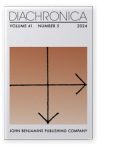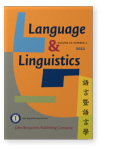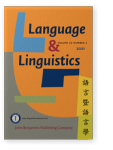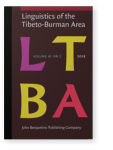Yunfan Lai
List of John Benjamins publications for which Yunfan Lai plays a role.
2024 Musk deer are inherited: The reconstruction of the onset *t.ɬj- in Proto-Gyalrongic Journal of Historical Linguistics: Online-First Articles | Article
This paper explores a rare sound correspondence pattern found in Gyalrongic languages, focusing on two etyma: ‘musk deer’ and ‘valley’. The reflexes in daughter languages exhibit different onsets, including palatals, alveolars, and laterals, which renders their genetic relationship non-obvious.… read more
2024 Mutual predictiveness of sound correspondences for reconstruction and language subgrouping: The case of Gyalrongic preinitials Diachronica 41:5, pp. 635–677 | Article
This paper uses Gyalrongic languages, a conservative branch of Sino-Tibetan, to illustrate a new method to evaluate proto-language reconstructions in general historical linguistics and to conduct exploratory analyses in language phylogeny. It first reconstructs a proto-system of Gyalrongic… read more
2023 Lenition alternation in West Gyalrongic and its implications for Southeast Asian panchronic phonology Diachronica 40:3, pp. 341–383 | Article
Based on internal reconstruction, this paper resolves a long-standing problem observed in Khroskyabs, a West Gyalrongic language (Sino-Tibetan), that seems to sporadically have lenited voiceless stops, resulting in irregular correspondences with East Gyalrongic. Two major sound changes are… read more
2022 From transitive to intransitive and voiceless to voiced in Proto-Sino-Tibetan: New evidence from Stau, Geshiza, and Khroskyabs Language and Linguistics 23:2, pp. 212–239 | Article
This paper offers new evidence from Stau, Geshiza, and Khroskyabs to address the question of directionality in valency-changing derivations in Sino-Tibetan. Examining Stau, Geshiza, and Khroskyabs causative and anticausative verb stem pairs adds to the evidence that in Proto-Sino-Tibetan, a… read more
2022 Preinitial denasalisation and palatal fortition in Khroskyabs and the Gyalrongic word for ‘man’ Linguistics of the Tibeto-Burman Area 45:2, pp. 211–229 | Article
There are four distinct forms conveying the meaning of ‘human, person, man’ across Gyalrongic languages. The default type (Japhug tɯ-rme), the rounded type (Khroskyabs vɟú), the Stau type (Geshiza vdzi) and the uvular type (Geletuo taˈʁap). Except for the default type, which has cognates in many… read more
2021 Come is the new go : The evolution of stem alternation of basic motion verbs in Khroskyabs Language and Linguistics 22:2, pp. 338–375 | Article
In this paper, I describe the morphology as well as the uses of the basic motion verbs, ‘to come’ and ‘to go’, in Khroskyabs based on two of its varieties, Siyuewu and Wobzi, before analyzing the evolutionary pathways of their stem alternation patterns. The meanings of the basic motion verbs in… read more
2018 Relativisation in Wobzi Khroskyabs and the integration of genitivisation Linguistics of the Tibeto-Burman Area 41:2, pp. 219–262 | Article
This paper focuses on the morphosyntax as well as the semantics of relativisation in Wobzi Khroskyabs, a Rgyalrongic language spoken in Sichuan, China. Different strategies of relativisation are presented, especially the nominalisation strategy. Wobzi Khroskyabs exhibits an innovative… read more





